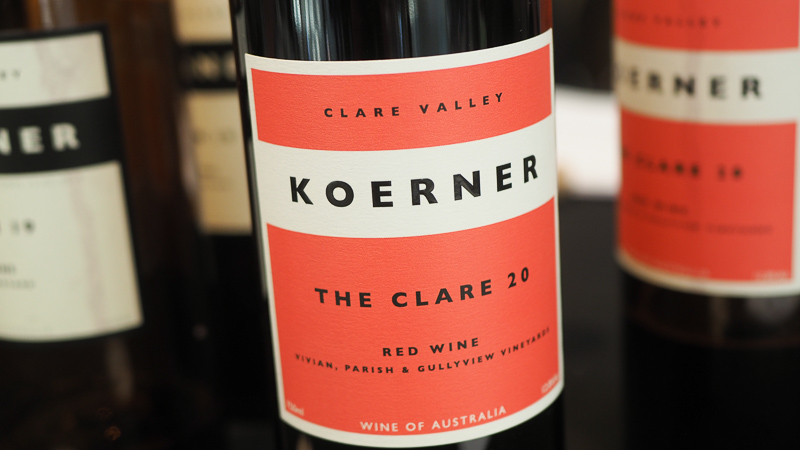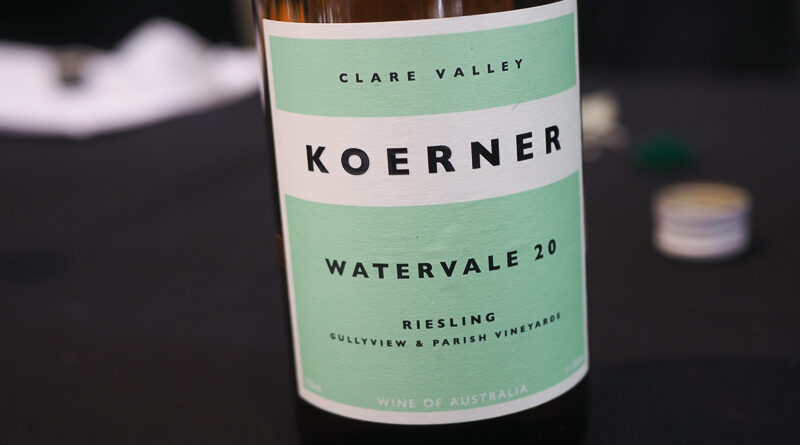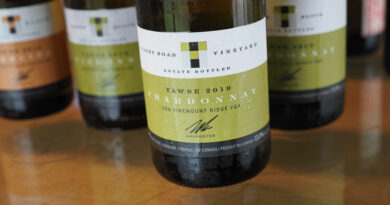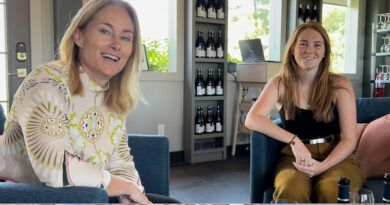Koerner: a new producer from the Clare Valley now making some of Australia’s most exciting wines
Website: https://koernerwine.com.au/
The vineyards that are behind new Clare Valley superstar Koerner have been in the family for 45 years now, but it’s only recently that they have been making their own wines. It’s all down to a well-travelled, curious second generation.
The Koerner family began growing grapes in Watervale, in the Clare Valley, in the mid-1970s. Sons Damon and Jono grew up on their parents’ vineyard. Both went travelling. Damon worked in Chablis (Château de Beru) and Alsace (Hugel), and Jono worked in Corsica. ‘We fell in love with the lifestyle, and a different style of wine,’ says Jono. In 2014 they decided to start Koerner wines together, sourcing the majority of their fruit from their parents’ vineyard in Watervale, but also buying grapes from two neighbouring vineyards.
Damon studied enology at Adelaide, and Jono has worked in cellars and done vintages around the place. ‘We thought we’d give it a crack,’ says Jono. I’m glad they did.
‘We grew up on the vineyards, and mum and dad have always sold grapes to other winemakers,’ says Damon. ‘So there was always that intrigue to see what happens after the growing.’ It’s a 60 hectare vineyard, and they use around 6 hectares of it. ‘Luckily dad lets us use the best blocks on the vineyard,’ says Damon, ‘but it took us a while to get these because there were contracts on them. We had to start with the shitty sites and work our way up.’
‘We try to as little as possible in the winery, and just help it through to bottle,’ he says. ‘We try to make wines that reflect place.’
The vineyard is on terra rossa soil with clay and limestone, in the southern part of Watervale. They like to play with classic varieties from Clare, but also throw in some alternative varieties, too.
‘We are lucky to work with some amazing fruit,’ says Damon. Many of the vines they are working with are old.
For reds, they have chosen varieties with high acid levels that they can pick early and get a ‘crisp drive’. Shiraz doesn’t work, but Grenache, Sangiovese and Cabernet do (although here the tannin makes up for the slight lack of acid).
For Riesling, their winemaking is unusual for the Clare. There is a mixture of fermenting in ceramic egg, stainless steel and Slavonian oak. The wines go through full malolactic and there is no fining of filtration. ‘We are trying to build texture into the wines,’ says Jono, ‘and some interest.’
House style is to pick early. ‘If we can taste one-in-four grapes that is ripe we pick the next day,’ says Jono. The result is wines with an unusual focus and precision, with a European sensibility, yet expressing the special characters of this part of the Clare Valley.

THE WINES
Notes by Jamie Goode (JG) and Treve Ring (TR)
Koerner Watervale Riesling 2020 Clare Valley, Australia
From Gullyview and Parish Vineyards in Watervale (with all three blocks that they work with for Riesling – Grace, Parish and Gullyview), planted in 1923 and 1973. 18 hours on skins in press, settled off solids for 3 days, natural ferment in 60% stainless steel, 30% ceramic amphorae, 10% Slavonian oak demi muids. Pithy and lively with lovely purity and great balance: lively with a lemon and lime core, some hints of green tea, and lovely texture and weight. It shows lovely purity and refinement. The acid integrates really well. 92/100 (JG)
Koerner Watervale Riesling 2019 Clare Valley, Australia
From Watervale’s Gullyview Vineyard, the riesling from these two blocks were planted in 1974 on southern Clare’s classic terra rosa soils (red clay on limestone). After a destemming and long, slow, gentle press (18 hours), this was native fermented in 40% ceramic amphora, 40% steel, and 20% Slavonian oak demi-muid for 2 months, before aging and tightening in stainless for 5 months prior to bottling without fining or filtration. Herbal led, this runs with pulpy lime, grapefruit, earthy lees, and mineral salts along a sleek, long, lighter (11.4 degrees) palate. Modern Clare, as intended. 90/100 (TR)
Koerner Grace Riesling 2020 Clare Valley, Australia
11.1% alcohol. pH 2.9, even after malolactic fermentation. North-facing with rich red clay soils, with limestone half a metre down. It’s from the Grace block from Gullyview vineyard, and was planted in 1974. This is crushed and destemmed, and is given 12 h on skins in the press. Cold settled for 3 days and then fermented in ceramic amphorae for 2 months. This is very fresh, pure, direct and limey with some grapefruit pith, very keen acidity, and bracing minerality. Great precision and purity here: this is a lovely linear Riesling, perhaps more typically Clare than the others. 93/100 (JG)
Koerner Gullyview Riesling 2020 Clare Valley, Australia
12.1% alcohol. The original Gullyview Riesling block planted in 1974. This is 25% ceramic, 75% stainless steel, and this is from south-facing bony limestone-rich soils, with very little top soil. 12 skin contact in press, 3 days settling. There’s a richness here with lively pear, citrus and green tea notes on the nose. The palate has lovely texture with a twist of ginger under the ripe citrus fruit, with really well integrated acidity and great purity. Finesse, linearity, but also a bit of generosity here. 94/100 (JG)
Koerner Parish Riesling 2020 Clare Valley, Australia
11.5% alcohol, pH 2.98. The Parish block has a tiny band of slate running through, together with red clay. It’s the first year they have had access to this vineyard: it belongs to their neighbour. Even though it is 200 m away from their vineyard, it is completely different. Planted in 1923. Fermented in 60% stainless steel and 40% ceramic amphorae. This is different again: taut and linear, with good acidity, but also a precise, crystalline, mineral citrus quality, with a bit of white peach and some grapefruit pith on the finish. Really tapers beautifully, and although it’s bone dry and has sky-high acid, the acid integrates really well. Great balance and purity. 94/100 (JG)
Koerner Pigato Vermentino 2020 Clare Valley, Australia
10.9% alcohol. This is the first wine they made, and it’s their best selling wine as well as their biggest production. One of two Vermentinos from the same block in Gullyview planted in 2009, and this was destemmed retaining 50% whole berries, with the rest pressed onto these skins. It spent 20 days on skins, fermenting in open-top fermenters, plunged twice daily. Then aged in stainless steel for 7 months. Complex nose of apple and pear with some floral hints. The palate is beautiful with some iced-tea character, a lovely chalky acid line, and some citrus, pear and apple fruit. It’s distinctive and quite beautiful with amazing precision and lots of interest. Finishes so fresh, with some herbal notes. Remarkable, considering how low the alcohol is (pH is 3.32). 93/100 (JG)
From Watervale’s Gullyview Vineyard, and its terra rossa soils, this vermentino was destemmed with 50% whole berry for a native ferment in open top steel, and with twice daily pigeage over its 20 days on skins. The free run and pressings were combined before resting in steel for 7 months. It was bottled without fining or filtration. First sniff / sip and all I can think is proper iced tea meets vermentino. Wow. Pouring a hazy lemon hue, with apricot fuzz, white peach and peach blossom, crunchy Asian pear taking the light bodied, textural palate. Though only 11% alcohol, this has a mouthfeel and presence that carries it beyond, though to a brisk and astringent wild orange finish. Would be lovely to have with complexly spiced Thai vegetarian or seafood curries, but sipping solo is also highly recommended. 91/100 (TR)
Koerner Rolle Vermentino 2020 Clare Valley, Australia
11.6% alcohol. This is the same fruit as in the Pigato. It has 18 hours skin contact in the press (it is crushed and destemmed) and then is settled for 24 h before fermentation in Slavonian oak demi-muids (500 litre barrels). It spends 9 months on full solids, then three months in stainless steel on fine lees. pH 3.18. This has an intriguing nutty, creamy, bready nose. The palate shows lively, fresh citrus fruit (lemons, a touch of mandarin) with some almond, honey and toasted bread character, as well as a touch of dairy. It’s very expressive, and there’s really keen acidity here, and it has a salty finish: it will be interesting to watch this evolve. 92/100 (JG)
Koerner Rolle Vermentino 2018 Clare Valley, Australia
Rolle, or Vermentino, is relatively recognized in Australia, and the Koerner brothers make one of the country’s top examples. This Rolle was organically farmed from 10 year-old vines planted on the Terra Rossa soils of Gullyview Vineyard. After a half day with skins, this was native fermented, and aged in both concrete and older oak foudres for additional texture and complexity (a welcome addition to the oft bland rolle). The fullness on the palate doesn’t reflect the meagre alcohol (11 degrees), but rather the careful handling and lower yields of the grape. Savoury rather than fruity, with meadow hay, broken stones, sea salts, honeyed melon, lemongrass and a tight, skippy acidity that prolongs the mineral, flint-flecked finish. Charismatic, new classic Clare. 92/100 (TR)
Koerner Mammolo Sciaccarello 2020 Clare Valley, Australia
13.2% alcohol, pH 3.22, TA 7.8 g/l. Planted in 1998, this comes from Vivian vineyards (another neighbour). This is usually bottled as a straight varietal wine in the south of Corsica (it’s Sciaccarello there), while in Tuscany it’s a minor blending component (known as Mammolo). They are the only ones in Australia who have this variety. It has huge berries and keeps good acidity. It’s destemmed and 50% whole bunches are retained. Aged in 2000 litre Slavonian oak foudres. This reminds me of Frappato – it’s a pale-coloured, aromatic red wine with floral sweet red cherry and plum fruit, as well as some raspberry and cranberry, as well as a slight hint of rhubarb. There’s some almond, too, and it’s beautifully textured with a smooth mouthfeel, hemmed by bright acidity and just a hint of tannic grip. Such a beautiful, expressive wine – this has smashability and purity, and I really love it. As an aside, everyone working in warm climates should try this variety! 95/100 (JG)
Sciacarello is an Italian red variety that is grown primarily in Corsica, known for its haunting floral perfume. From Watervale’s Vivian Vineyard, planted im 1998 on clay and limestone, this light red preserves the grape’s alluring nature. This was destemmed with 50% whole berry (no whole bunch) before native ferment in steel with twice daily pigeage for two weeks. This then ages in ceramic amphora for 3 months prior to moving into steel for 7 months of tightening, then bottling without fining or filtration. Light and fragrant with herbal cherry, wild raspberry, perfumed plum on a finessed, light palate. Tannins are whisper fine and long, and acidity is effortlessly lofted to a lingering wildflower kissed, saline laced finish. Such a pretty, striking, and charismatic wine. 93/100 (TR)
Koerner Mammolo Sciaccarello 2019 Clare Valley, Australia
From Watervale’s Vivian Vineyard, planted in 1998 on clay and limestone, this light red preserves the grape’s alluring nature. This was destemmed with 50% whole berry (no whole bunch) before native ferment in steel with twice daily pigeage for two weeks. This then ages in ceramic amphora for 3 months prior to moving into steel for 7 months of tightening, then bottling without fining or filtration. Pouring a cloudy crimson hue, this charmer is imbued with mesmerizing floral plum, cherry, pomegranate, wild raspberry, and sapid thorns along a slender 13.2 degrees body. There’s a wash of mineral salts rinsing over this fresh red, netted with fine tannins and strung with grapefruit acidity which guide this to a lingering finish. From the hue to the aroma to the finish, there’s an ethereal character to this wine, and an easy reason for you to seek out Sciacarello – plus keep an eye on the Koerner brothers. 93/100 (TR)
Koerner La Korse Red Wine 2020 Clare Valley, Australia
13.1% alcohol. A blend of 40% Sangiovese, 31% Sciaccerello, 19% Grenache, 6% Malbec, 4% Carignan. It’s a Corsican-inspired red. Destemmed with 50% whole berries. Aged in stainless steel. This is floral and bright with really focused, pure red berry fruit and a touch of anise and dried herbs on the nose. The palate is pure, fresh and vibrant with a nice sour cherry finish and an Italian sensibility, with lovely fresh red fruits combined with nice bitterness, crunch and pleasant sourness. A brilliantly versatile, crunchy red wine with focus and drinkability. I really like this, and it should age well. 94/100 (JG)
Koerner La Korse Red Wine 2019 Clare Valley, Australia
From Watervale’s Vivian, Gullyview and Parish Vineyards, in the southern Clare Valley and plantings from planted from 1935 to 1998 on terrarosa and limestone soils, this is a blend of sangiovese, grenache, malbec, sciacarello, and carignan. The parts were solo native fermented whole berry (50%) and then transferred to ceramic egg and neutral oak, where it remained for three months before blending and an additional five months’ ageing. It was bottled without fining or filtration. Pouring a cloudy, pale crimson hue, this lighter red is tightly woven with potent salinity running throughout layers of red currant, wild raspberries, pomegranate, mustard seed, rosehips, wet rocks to a lingering, haunting finish. Acidity is crunchy and lofted, and tannins are bamboo fine, shouldering this slight red seamlessly. Enjoy this serious/smashable red with a chill. 92/100 (TR)
Koerner Niellucio Sangiovese 2020 Clare Valley, Australia
12.5% alcohol. This uses two names for the same variety. It’s from Vivian vineyard, planted in 1998. Like all the reds, fermented destemmed in open-top fermenters for about two weeks. Aged in 2000 litre foudres. It’s really fresh and vibrant with keen acidity under the bright cherry and plum fruit. There are some herbal notes, and a bit of tannic grip. Edgy and quite spicy, with a juicy character and a brisk tannic finish. Lots of prettiness here, but also a slight savoury edginess. Tastes like Sangiovese. Some firmness here, coupled with high acid. 92/100 (JG)
Koerner Vivian 2019 Clare Valley, Australia
This is the fellows’ take on a Super Tuscan, with the addition of 5% Sangiovese, and 2% Sciaccarello, so you can think of this as their Super Clare. From their organically farmed Vivian Vineyard’s black and red clay on limestone, this was destemmed, with 50% whole berries (no whole bunch) before a native ferment in open top steel fermenters, hand plunged twice daily, over 3 weeks. It was then moved to French demi-muid for 10 months, prior to a tightening stint in steel for 2 months. This is a more powerful, chewy wine, yet still lofted with the effortless buoyant acidity that is characteristic of their wines. Ripe cherry, raspberry leather, dried cherry, red florals, oregano, fragrant kirsch is drawn along the medium-bodied palate, plumed by the clay soils, and propelled by sticky, ample tannins. All of course is offset by the acidity. Open this powerful wine in advance to allow it to unfurl. 91/100 (TR)
Koerner Cot Malbec 2020 Clare Valley, Australia
12.5% alcohol. From Parish Vineyard, planted in 1998. Aged in foudre. Malbec is suited to the Clare: they can get full flavour with freshness, and they’ve taken inspiration with what Wendouree have done with this variety. This is so supple and pretty with juicy cherry and plum fruit, and nice freshness. There’s an ease here: it shows freshness, juicy cherry and plum fruit, but also a nice chalky minerality. It responds well to be picked early with lovely fruit. Maybe not a long ager: drink this young and vibrant. 93/100 (JG)
Koerner The Clare 2020 Clare Valley, Australia
12.8% alcohol. This is their idea of what the Clare Valley tastes like. The blend changes each year. 2020 is 51% Cabernet Sauvignon, 15% Cabernet Franc, 12% Malbec, 12% Grenache, 9% Carignan and 1% Sciaccarello. There’s a fine green leafy edge to the blackcurrant and cherry fruit nose. It’s fresh, luxurious, bright and nuanced, with a nice green hint sitting under the drinkable, juicy berry and black fruits. It’s really refined: this captures the red side of Clare Valley in the glass beautifully. Very fine and elegant. 94/100 (JG)
The Koerner brothers like to show a neoclassic view of their home, Clare Valley, and it’s wines like this, The Clare, that typify their MO. This is their take on a Bordeaux blend. Half cabernet sauvignon, the remainder is malbec, grenache, and cabernet franc, from the terra rossa soils of Vivian, Parish, and Gullyview Vineyards, and vines planted in 1930 and 1998. This vintage was 50% whole berry (no whole bunch), native fermented in open top steel for two weeks on skins, and then racked into Slavonian foudre for 9 months. This was returned to steel for 3 months prior to bottling unfined and unfiltered, and with a minimum of sulphur. Sappy plum, tayberry, raspberry fill a sun-ripened palate, with crunchy green branch notes threaded throughout. Tannins are sticky, guiding this medium bodied red through the gently spiced finish. Drinking well now. 90/100 (TR)
Koerner The Clare 2019 Clare Valley, Australia
This is their take on a Bordeaux blend. Half Cabernet Sauvignon, the remainder is Malbec, Grenache, and Cabernet Franc, from the terra rossa soils of Vivian, Parish, and Gullyview Vineyards, and vines planted in 1930 and 1998. This vintage was 50% whole berry (no whole bunch), native fermented in open top steel for two weeks on skins, and then racked into Slavonian foudre for 9 months. This was returned to steel for 3 months prior to bottling unfined and unfiltered, and with a minimum of sulphur. An atypical Oz Bx blend from the start, with only 13 degrees, this slightly hazy, fresh red teems with dusky violet, plum, morello cherry, anise along a medium bodied palate, housed with lightly furry tannins. The lingering finish haunts with a perfumed purple florality and a lick of kirsch. 91/100 (TR)
Koerner The Clare 2018 Clare Valley, Australia
This Cabernet Sauvignon, Malbec, Petit Verdot, Cabernet Franc blend is from the brothers Koerner, always known for turning Clare on its head. Sourced from the Vivian and Bass Hill Vineyards, The Clare is the bro’s idea of a modern Bx blend. Mostly whole berry, this was native fermented in open fermenters for two weeks before being pressed into tank for a few days and then racked into a mix of ceramic egg and old oak, where it rested for three months. Purple and blue florals, fleshy plum, blueberries, morello cherry, and a slick of winter cool mint glide along the slick palate of The Clare, gripped by thorny sides, and riding a wild blackberry / blackcurrant wave to a snappy finish. Tannins are soft, and acidity is bright, as intended, for drinking now in youth. 90/100 (TR)
Koerner Classico 2020 Clare Valley, Australia
13.5% alcohol. 70% Cabernet Sauvignon, 20% Malbec, 6% Sangiovese, 4% Grenache. 15% new oak, all French demi muids. Will be released in a while. This is ripe and fresh with sweet blackcurrant fruit as well as some leafy green notes, but also some plum, raspberry and spice. The oak is hidden behind the intense fruit. There’s a brightness and drinkability here, but also some seriousness and the ability to age. I think the nailing the picking, plus the modest extraction has made this a wine that has early drinkability, but also the potential for a lot of development. It’s so impressive. 94/100 (JG)
Koerner Classico 2017 Clare Valley, Australia
This is the Koerner brothers’ take on the classic Clare Valley Cabernet Malbec blend, made famous by the legendary Wendouree Vineyards. In the boys’ modern remix however, cabernet sauvignon is splashed with 15 percent Malbec, and 15 percent Petit Verdot, coming of off three Watervale vineyards’ red clay over limestone soils. The fruit was destemmed and native fermented before moving to used barriques for 4 months before the final blend was made. Once blended, the wine was transferred to a 3 year old 700L French barrel and 1 ceramic egg for 6 months, then bottled unfined and unfiltered. Dusky blackberry, black plum, inky cassis, perfumed violets is etched with balsamic and drawn along long, sueded tannins. The mouthfeel is brooding and drawn slowly, though fine acidity easily carries the weight (13.1 degrees). Serious, though a bit sluggish. 89/100 (TR)
UK agent: Graft Wine
Find these wines with wine-searcher.com




